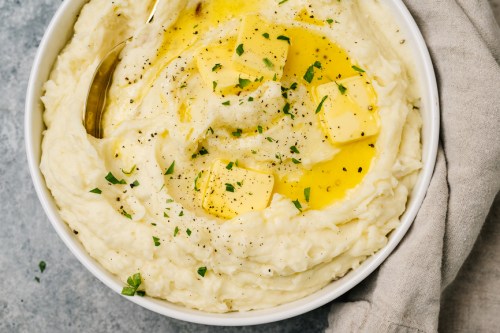With the holiday season around the corner or, frankly, any festivity, finessing the perfect potato recipe (ahem, which starts with knowing exactly how long to boil potatoes) can be the difference between getting all of the praise from your family (and endless requests for the recipe) and an embarrassing walk of shame as you leave the get-together with a container filled with untouched leftovers of your own dish.
To spare yourself any last-minute kitchen chaos, there’s one vital yet super easy cooking technique that can help you master this deceivingly complex spud in a matter of seconds. And it boils down to (literally) the temperature of the water you use to cook your potatoes. We’ve gathered the perfect guide for knowing exactly how long to boil potatoes depending on what you’re making (think mashed, fries, and roasted spuds). So, if you’re ready to transform your Russets and Yukon Golds into delicious—not mealy—nourishing potato dishes, listen up!
How Long To Boil Potatoes
We’re just going to come right out and say it: Stop cooking potatoes as if they’re pasta. When making a batch of macaroni and cheese, you typically wait until a large pot of water has come to a rolling boil and then throw in your noodles—which might naturally seem like the right thing to do when it comes to potatoes, too. However, this isn’t the case. Instead, it’s a one-way ticket to mealy, mushy spuds. No, thank you.
The good news is that avoiding this grim destiny for one of our favorite gut-friendly veggies of all time is beyond simple: Toss them into the pot of water while it’s still cold, and then bring it to a boil. Why? As the water slowly warms up, the hard potatoes can cook all the way through more evenly. If you add them once the water is already boiling, it’ll cook the outside surface much faster than the inside—which may be why you continuously need to add a few more minutes to the timer as you keep finding they’re too hard in the center when pierced with a knife (and slowly disintegrating on the outside).
The Best Types of Potatoes for Boiling
It’s also important to note that not all potatoes share the same characteristics—and some are better suited for making crispy roasted potatoes versus creamy mash than others. Generally speaking, there are three main categories of potatoes: starchy, waxy, and all-purpose. Starchy potatoes are like Russet or Japanese sweet potatoes, which are starchier on the inside, have low moisture content, and easily break down when cooked. These are ideal for frying and baking to prepare dishes like french fries, mashed potatoes, baked potatoes, or gnocchi.
The second type is waxy. Think: New potatoes, Red Bliss, pee wees, and fingerlings. They’re generally low in starch and high in moisture and have creamier flesh and waxy skin. They also tend to hold their shape better when cooked and are best suited for dishes like gratins, pommes anna, soups, or salads—where you want to keep their shape intact and not disintegrate upon touch or first bite.
Lastly, all-purpose potatoes like Yukon Gold, white, and blue (or purple) potatoes can pretty much do it all. These can be roasted, pan-fried, stewed, mashed; you name it. (BTW, Yukon Gold potatoes are usually the best for mashed potatoes due to their well-balanced starchiness and naturally buttery flavor.) Another one of our favorite ways to cook gold potatoes (aka one of the best potatoes for roasting) is by turning them into this batata harra recipe that helps fight inflammation and is air fryer-friendly.
TL;DR? Of the three, waxy potatoes are best for boiling, as the low starch content and creamy interior help them maintain their shape as they cook down. On the flip side, starchy potatoes can easily be overcooked or waterlogged when boiled—so don’t expect them to make a rich and smooth mashed potato. Basically, like most things in life, there’s a time and, err, potato for everything.
How To Prep Potatoes for Boiling
First things first, you’ll want to prep your potatoes for boiling ahead of time. Since spuds grow underground, it’s common for them to have some traces of dust, dirt, and grime when you pick them up at the store. Thus, giving them a thorough wash under cool, cleaning running water should be step number one. Although the gentle rubbing of your fingers on the skin to help remove the grit will usually do the trick, you can always use a vegetable brush to further release anything left behind.
Additionally, it’s worth noting that even if you intend on peeling the potatoes after they’ve been cooked, a good rinse is always beneficial to help eliminate traces of pesticides and reduce the chance of spreading foodborne illnesses once it’s cut into. So, it’s important to wash potatoes even if the skin will be removed.
Next, if you are making a dish that requires peeled potatoes, you’ll want to remove the skins before you boil them. Why? Handling a hot, recently boiled potato is definitely not recommended. Plus, removing the skin on an uncooked potato is much easier if you have the right equipment. (A Y-peeler is a great tool for maneuvering the nooks and crannies on a potato’s surface.)
Is it better to boil potatoes whole or cut up?
Then, once your potatoes are peeled, you can either keep the potato whole or chop it up into smaller chunks. The smaller the pieces, the faster the potatoes will soften, which can help expedite the cooking process, especially if you’re in a rush. Additionally, smaller pieces are much easier to work with if making a dish from scratch, like mashed potatoes, which involves some heavy-duty arm work.
What is the fastest way to boil potatoes?
Keep in mind that to ensure they all cook as evenly as possible, it’s important to cut them as similarly shaped as possible. That way, all of the potato chunks will be ready at the same time, and you won’t need to stick a knife into every piece in the pot to test its doneness level.
Should You Salt the Water When Boiling Potatoes?
Although the way you cook potatoes and pasta isn’t the same, they do share one thing in common: Salting the water is a must. When potatoes and pasta warm up, the starches in these foods can more easily absorb flavors in the cooking liquid than when raw or cooled down. This is why it’s also important to salt the water—salty like the sea—when you make potatoes, too. Unless you’re okay with under-seasoned mashed potatoes…which is a crime in my book. Plus, for even more flavor, you can also substitute plain ol’ water for veggie or chicken broth to further infuse the neutral-tasting spuds with even more deliciousness.
BTW, the rule of thumb is to add about one to two tablespoons of salt per pound of potatoes into the cooking liquid. However, we won’t stop you from adding a bit more to guarantee they’re as flavorful as can be. Or you can always add a few additional flavoring ingredients like vegan or dairy-free butter and cream for the perfect and luscious mashed potatoes you’ll ever have.
A registered dietitian shares all of the benefits of potatoes:
Sign Up for Our Daily Newsletter
Get all the latest in wellness, trends, food, fitness, beauty, and more delivered right to your inbox.
Got it, you've been added to our email list.











